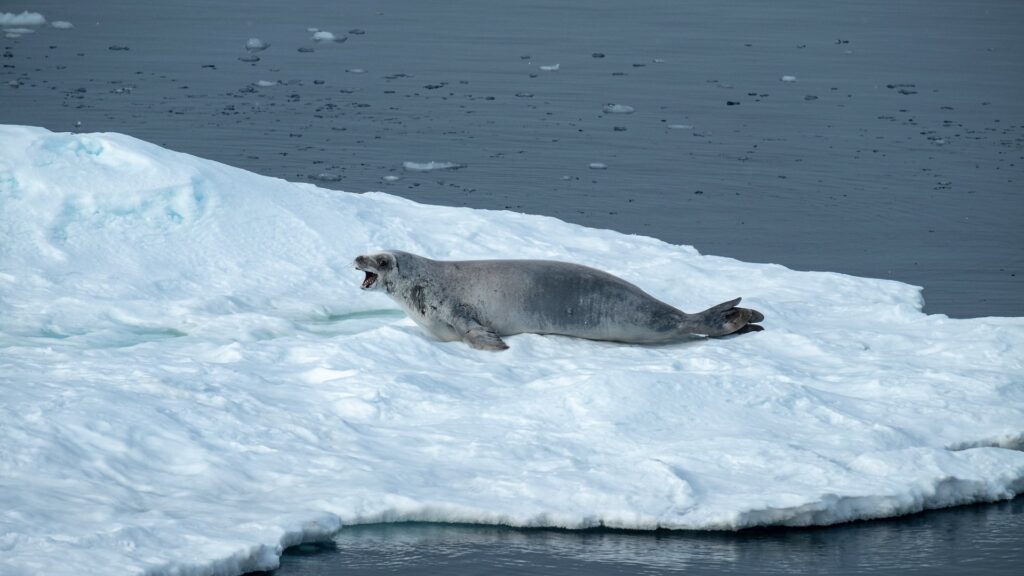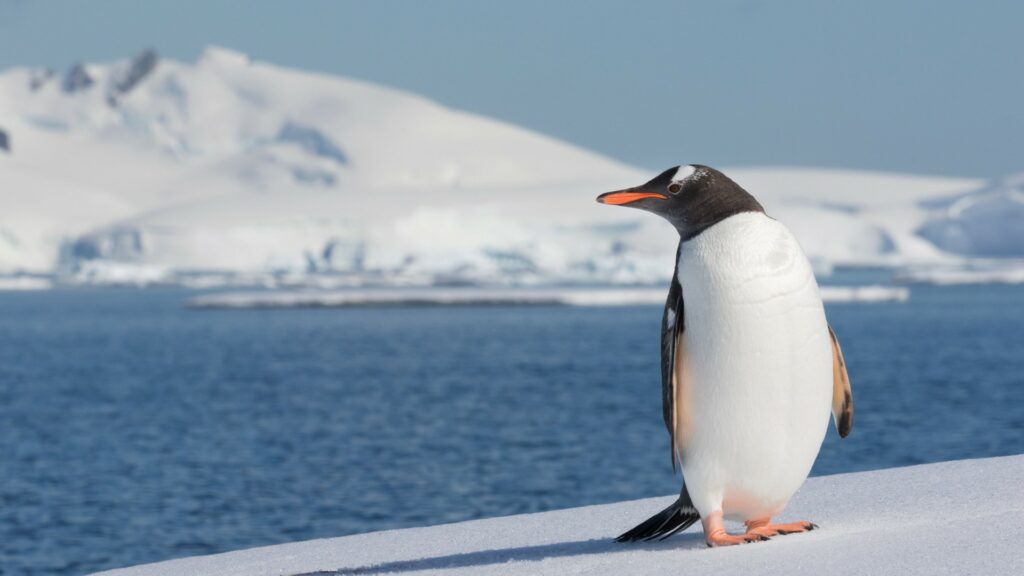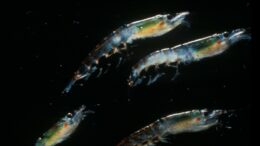If you love penguins, whales and a livable climate, then it might be time to stand up for Antarctic krill.
These shrimp-like crustaceans occur around Antarctica but are most highly concentrated in the Antarctic Peninsula, which also happens to be one of the fast-warming places on the planet. That’s bad news for krill — and everything that depends on them — which is a lot.
Only a few inches long, Antarctic krill (Euphausia superba) may be small, but their contributions to the ecosystem are massive — much like the swarms themselves. They form the base of the food web in the Southern Ocean, which circles Antarctica and makes up about 10% of the global ocean.
Most animals living in and around Antarctica dine on krill. That includes sea birds, whales, penguins, seals, squid, and numerous species of fish that live in the open ocean.
“Krill play such a fundamental role in the ecosystem, not just for the top predators, but also for smaller predators,” says Kim Bernard, an associate professor at Oregon State University who’s currently in Antarctica studying the crustaceans. “Almost everything down here feeds on them. And if they don’t feed directly on Antarctic krill, they’ll feed on something that does.”

Krill help support a diversity of marine life, but they also play a major role in biogeochemical cycling by trapping carbon in the deep sea — something that benefits even those of us that live far from its frigid waters.
While krill have been spotted thousands of feet deep on the seafloor, they also come up to the surface of the water to feed on algae that absorb carbon dioxide. “When the krill migrate down in these massive swarms and excrete their waste, that transfers a large amount of that carbon to ocean depths,” explains Nicole Bransome, an officer with the Pew Bertarelli Ocean Legacy Project.
One of the Southern Ocean’s most important aspects is its capacity to take up carbon. “And a huge player in that is krill,” says Bernard. “They’re worth fighting for.”
And the time to do that, experts warn, is now.
Dual Threats
While krill are abundant, researchers have seen a downward trend in population size, says Bernard, and their distribution is shifting. Climate change is one culprit.
Sea ice is important for krill lifecycles, especially in the juvenile stage, but warming temperatures are decreasing sea ice in the region.
A 2019 study in Nature Climate Change found that krill had shifted the center of their distribution south by 275 miles in the past 40 years. “The changing distribution is already perturbing the krill-centered food web and may affect biogeochemical cycling,” the researchers found.
Another study found that declining krill numbers could cause penguin populations to crash by 30% in one part of the region.
Climate change isn’t the only threat. Krill are also a target for industrial fishing vessels. (Yes, humans eat krill, too, as do our pets.) This fishing puts a lot of other species at risk.
“Most of the fishing happens in these really small nearshore areas where predators like penguins, whales, seals, and other animals feed,” says Bransome. “This hyper-concentrated fishing, in conjunction with climate change, is already having a negative impact on penguins in particular in the Antarctic peninsula.”
The intensity and duration of fishing efforts is also a concern, says Bernard.
“I’ve noticed that in recent years the fishing season has pushed further into the winter because there isn’t a seasonal closure,” she says. “And with less sea ice along the Antarctic Peninsula in the wintertime, the ships can just stay down there for longer.”
Global Action
There’s much that can be done. The Southern Ocean is managed by an international body of 27 members known as the Commission for the Conservation of Antarctic Marine Living Resources.
The Commission is working on two fronts that could aid krill. The first is developing and implementing a science-based plan that would help spread out fishing in both space and time to ease pressure on predators.
The second is designating a network of marine protected areas. A big step on this front occurred in 2016 with the establishment of the Ross Sea Marine Protected Area — the largest in the world.

But efforts to designate three more Antarctic marine protected areas have been blocked by just two Commission member states. China and Russia have prevented it from reaching the consensus that it needs for designation, says Bransome. The most recent stalemate came at a June meeting.
“A lot of people were very disappointed by that outcome,” says Bransome. “It seems Antarctica’s melting faster than CCAMLR members are acting to protect it.”
Conserving more areas of the Southern Ocean wouldn’t just benefit Antarctica, but could also help propel efforts to protect 30% of the ocean by 2030, which global leaders recently agreed to under the Convention on Biological Diversity.
“Designating these marine protected areas, which are mature and ready, would be one of the best ways to actually move towards meeting that objective in the relatively short amount of time that’s left between now and 2030,” says Bransome.
The three proposed areas — in East Antarctic, the Weddell Sea and the Antarctic Peninsula — would not just help krill but conserve habitat and protect biodiversity for a huge range of the region’s species.
“Adélie and chinstrap penguins get almost all of their calories from krill,” says Bransome. “Other predators that would benefit include crabeater seals, fur seals, gentoo penguins, and whales, like humpback and fin whales, that are having massive population recoveries after experiencing centuries of exploitation themselves.”
Large protected areas that are free from pressures of industrial fishing can also better help animals build resilience to stresses from climate change. And a network of areas would allow animals to migrate between such spaces for breeding and foraging.
Bransome says she’d like the United States, which helped develop the Ross Sea Marine Protected Area, to apply that same leverage to establishing new areas in the region.
The United States “could try to replicate that success and really make this issue a top political priority and continue to work closely with other proponents,” says Bransome. “France, Germany and Australia would be a few key ones to continue to engage with China and Russia via top diplomatic and technical channels to try to find a solution to finally reach consensus on designating the proposed protected areas.”
Personal Action
While global action is needed to protect Antarctica and the Southern Ocean, there’s a lot individuals can do, too. One of the biggest drivers of the krill fishing industry are omega-3 supplements. But consumers have other options besides krill, including marine algae.
“There are lots of different alternatives,” says Bernard. “The fats that the krill have inside them, that are supposedly so valuable to us, actually come from plants. So we could go directly to the source.”
Krill is also used by the aquaculture industry for raising farmed salmon, which comes with its own set of environmental problems.
Demand for the tiny crustaceans doesn’t stop there. “The industry is also developing some new products, including protein powder, and they’re starting to sell actual krill meat itself for human consumption,” says Bransome. “I would say the biggest growth markets for krill products right now are North America and Asia.”
Beyond leveraging consumer power, individuals can take action on climate change and conservation.
“People can reach out to government officials to let them know how important Antarctic conservation is, and reduce their individual carbon emissions,” says Bransome. They can also look for ways to spread the word to their communities about the importance of the Antarctic and krill. A good time to start is World Krill Day on Aug. 11.
Happy #WorldKrillDay 🦐 Krill capture carbon and feed other species – they are a ‘keystone’ species of the Southern Ocean @AusAntarctic @pewenvironment @CCAMLR1 https://t.co/to20itPIkC
— Australian Antarctic Program Partnership (@Ant_Partnership) August 11, 2022
We also need more awareness about the importance of Antarctica and the Southern Ocean in general, she says.
“I think so many people just think it’s this place that has penguins and it doesn’t impact anyone,” says Bransome. “But it’s often referred to as the ‘beating heart of the planet,’ because the currents send nutrients to the global ocean feeding fisheries and biodiversity throughout the ocean. It stores the majority of heat and carbon that’s created. It really impacts us all.”
Previously in The Revelator:
‘We Found Plastic on the Seabed in Antarctica and I Just Cried’
![]()


